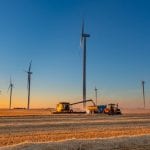Around The Web
EU Market: EUAs retreat after hitting new six-week high above €29
New jurisdictional REDD standard could begin yielding offsets in 2021
'Enormous opportunity': how Australia could become the Saudi Arabia of renewable energy
The remote Western Australian town of Kalbarri could find itself at the bleeding edge of a renewables revolution
Brandon Bickford is only in town for the weekend. The 26-year-old has come back home to Kalbarri, the tiny Western Australian town where he grew up, with his fiancée to visit family. He’ll be making the 574km drive back south to Perth on Monday morning.
The young man with an athletic build says growing up here was like living in the flipside of a postcard. In his teenage years he “ran amok” between the ancient cliffs that hug the coast and the rugged natural landscape that stretches out to the horizon.
Continue reading...The Green Recovery: how Australia can ditch coal (without ditching jobs) – video
Australia loves coal. About 60% of our electricity still comes from polluting, coal-fired power plants, while only 20% comes from renewables. Successive governments have told us that decommissioning coal-fired power would hurt the economy and cause a wave of unemployment. But that's not actually true. In fact, there are enormous opportunities to create jobs and wealth in renewable industries in Australia, including in exporting to countries without the sun and space we enjoy here
Continue reading...The Green Recovery: how Australia can ditch coal (without ditching jobs) – video
Australia loves coal. About 60% of our electricity still comes from polluting, coal-fired power plants, while only 20% comes from renewables. Successive governments have told us that decommissioning coal-fired power would hurt the economy and cause a wave of unemployment. But that's not actually true. In fact, there are enormous opportunities to create jobs and wealth in renewable industries in Australia, including in exporting to countries without the sun and space we enjoy here
Continue reading...Joint venture looks to invest billions in 'natural capital' projects to help combat climate change
Founding partner says ‘investing in the resilience of nature is investing in the resilience of the economy’
A push to better recognise the economic value of “natural capital” – water systems, biodiversity, soil and carbon stores – has prompted the creation of what aims to be the world’s largest investment firm dedicated to projects that help the planet.
Multinational financial services giant HSBC and Pollination, a boutique climate advisory and investment firm, announced a joint venture that they predicted would meet a multi-billion dollar demand for environmentally friendly investment beyond renewable energy.
Continue reading...August heatwave sends California power consumption above 2019 levels
Mauritius: Anger and questions as 17 dead dolphins wash ashore
Icelandic direct air capture project scales up carbon removals
Romanian industry under pressure amid delayed indirect ETS cost payments
Bread price may rise after dire UK wheat harvest
HSBC, Pollination team up to launch world’s largest natural capital offset fund
New wind and solar improving grid reliability and lowering costs, AEMO says
 AEMO says all states expected to be within new reliability standard this summer thanks to new wind and solar capacity, but catastrophic events still a risk.
AEMO says all states expected to be within new reliability standard this summer thanks to new wind and solar capacity, but catastrophic events still a risk.
The post New wind and solar improving grid reliability and lowering costs, AEMO says appeared first on RenewEconomy.
Norway plans to drill for oil in untouched Arctic areas
Critics say plan for fields off Svalbard threatens ecosystem and relations with Russia
Norway is planning to expand oil drilling in previously untouched areas of the Arctic, a move campaigners say threatens the fragile ecosystem and could spark a military standoff with Russia.
A public consultation on the opening up of nine new Norwegian oilfields closed on Wednesday. The areas in question are much further north in the Arctic than the concessions the US president, Donald Trump, announced for Alaska this month.
Continue reading...China performs first test of national ETS registry
Eigg beach runner stumbles on dinosaur bone
Unless we change course, the US agricultural system could collapse | Tom Philpott
Our food supply comes from an environmentally unsustainable system that is going to unravel
Picture an ideal dinner plate. If you’re like most Americans, it features a hearty portion of meat, from animals fattened on midwestern corn and soybeans, and a helping of vegetables, largely trucked in from California. The unique landscapes we rely on to deliver this bounty – the twin jewels of the US food system – are locked in a state of slow-motion ecological unravelling.
California’s agricultural sector has flourished from decades of easy access to water in one of the globe’s biggest swaths of Mediterranean climate. The Sierra Nevada, the spine of mountains that runs along California’s eastern flank, captures an annual cache of snow that, when it melts, cascades into a network of government-built dams, canals and aqueducts that deliver irrigation water to farmers in the adjoining Central Valley. In light-snow years, farmers could tap aquifers that had built up over millennia to offset the shortfall.
Continue reading...


